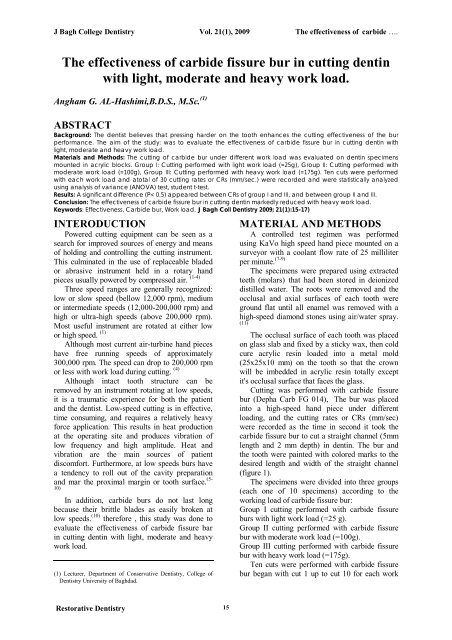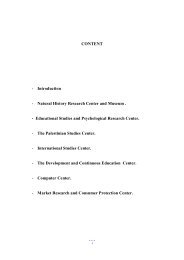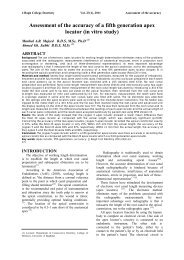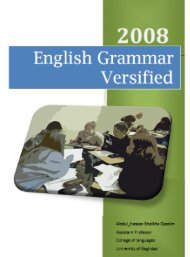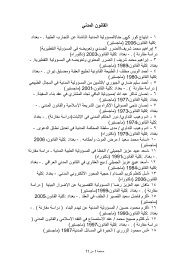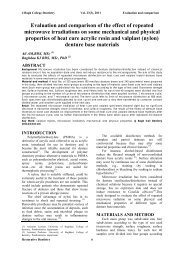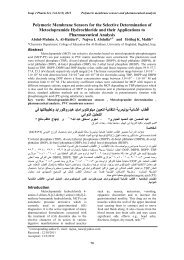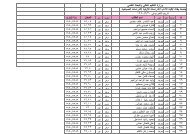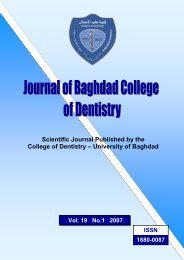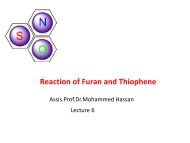Vol 21 No. 1
Vol 21 No. 1
Vol 21 No. 1
Create successful ePaper yourself
Turn your PDF publications into a flip-book with our unique Google optimized e-Paper software.
J Bagh College Dentistry <strong>Vol</strong>. <strong>21</strong>(1), 2009 The effectiveness of carbide ….<br />
The effectiveness of carbide fissure bur in cutting dentin<br />
with light, moderate and heavy work load.<br />
Angham G. AL-Hashimi,B.D.S., M.Sc. (1)<br />
ABSTRACT<br />
Background: The dentist believes that pressing harder on the tooth enhances the cutting effectiveness of the bur<br />
performance. The aim of the study: was to evaluate the effectiveness of carbide fissure bur in cutting dentin with<br />
light, moderate and heavy work load.<br />
Materials and Methods: The cutting of carbide bur under different work load was evaluated on dentin specimens<br />
mounted in acrylic blocks. Group I: Cutting performed with light work load (=25g), Group II: Cutting performed with<br />
moderate work load (=100g), Group III: Cutting performed with heavy work load (=175g). Ten cuts were performed<br />
with each work load and atotal of 30 cutting rates or CRs (mm/sec.) were recorded and were statistically analyzed<br />
using analysis of variance (ANOVA) test, student t-test.<br />
Results: A significant difference (P< 0.5) appeared between CRs of group I and III, and between group II and III.<br />
Conclusion: The effectiveness of carbide fissure bur in cutting dentin markedly reduced with heavy work load.<br />
Keywords: Effectiveness, Carbide bur, Work load. J Bagh Coll Dentistry 2009; <strong>21</strong>(1):15-17)<br />
INTERODUCTION<br />
Powered cutting equipment can be seen as a<br />
search for improved sources of energy and means<br />
of holding and controlling the cutting instrument.<br />
This culminated in the use of replaceable bladed<br />
or abrasive instrument held in a rotary hand<br />
pieces usually powered by compressed air. (1-4)<br />
Three speed ranges are generally recognized:<br />
low or slow speed (bellow 12,000 rpm), medium<br />
or intermediate speeds (12,000-200,000 rpm) and<br />
high or ultra-high speeds (above 200,000 rpm).<br />
Most useful instrument are rotated at either low<br />
or high speed. (1)<br />
Although most current air-turbine hand pieces<br />
have free running speeds of approximately<br />
300,000 rpm. The speed can drop to 200,000 rpm<br />
or less with work load during cutting. (4)<br />
Although intact tooth structure can be<br />
removed by an instrument rotating at low speeds,<br />
it is a traumatic experience for both the patient<br />
and the dentist. Low-speed cutting is in effective,<br />
time consuming, and requires a relatively heavy<br />
force application. This results in heat production<br />
at the operating site and produces vibration of<br />
low frequency and high amplitude. Heat and<br />
vibration are the main sources of patient<br />
discomfort. Furthermore, at low speeds burs have<br />
a tendency to roll out of the cavity preparation<br />
and mar the proximal margin or tooth surface. (5-<br />
10)<br />
In addition, carbide burs do not last long<br />
because their brittle blades as easily broken at<br />
low speeds. (10) therefore , this study was done to<br />
evaluate the effectiveness of carbide fissure bar<br />
in cutting dentin with light, moderate and heavy<br />
work load.<br />
(1) Lecturer, Department of Conservative Dentistry, College of<br />
Dentistry University of Baghdad.<br />
MATERIAL AND METHODS<br />
A controlled test regimen was performed<br />
using KaVo high speed hand piece mounted on a<br />
surveyor with a coolant flow rate of 25 milliliter<br />
per minute. (7-9)<br />
The specimens were prepared using extracted<br />
teeth (molars) that had been stored in deionized<br />
distilled water. The roots were removed and the<br />
occlusal and axial surfaces of each tooth were<br />
ground flat until all enamel was removed with a<br />
high-speed diamond stones using air/water spray.<br />
(11)<br />
The occlusal surface of each tooth was placed<br />
on glass slab and fixed by a sticky wax, then cold<br />
cure acrylic resin loaded into a metal mold<br />
(25x25x10 mm) on the tooth so that the crown<br />
will be imbedded in acrylic resin totally except<br />
it's occlusal surface that faces the glass.<br />
Cutting was performed with carbide fissure<br />
bur (Depha Carb FG 014), The bur was placed<br />
into a high-speed hand piece under different<br />
loading, and the cutting rates or CRs (mm/sec)<br />
were recorded as the time in second it took the<br />
carbide fissure bur to cut a straight channel (5mm<br />
length and 2 mm depth) in dentin. The bur and<br />
the tooth were painted with colored marks to the<br />
desired length and width of the straight channel<br />
(figure 1).<br />
The specimens were divided into three groups<br />
(each one of 10 specimens) according to the<br />
working load of carbide fissure bur:<br />
Group I cutting performed with carbide fissure<br />
burs with light work load (=25 g).<br />
Group II cutting performed with carbide fissure<br />
bur with moderate work load (=100g).<br />
Group III cutting performed with carbide fissure<br />
bur with heavy work load (=175g).<br />
Ten cuts were performed with carbide fissure<br />
bur began with cut 1 up to cut 10 for each work<br />
Restorative Dentistry 15


